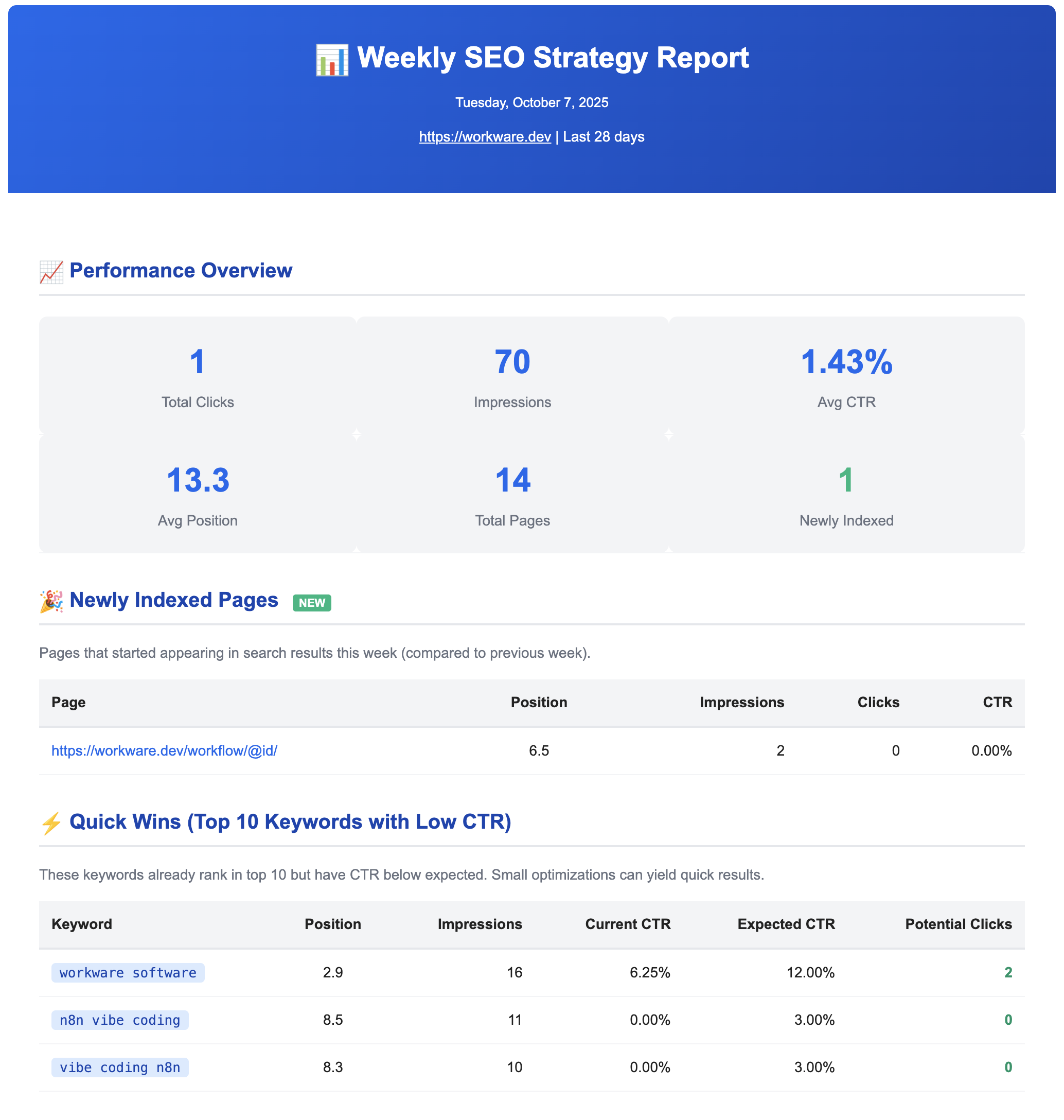
The New Content Bottleneck (And How Automation Can Help)
Here's the paradox every content creator faces in 2025: You can spin up a blog post in an hour with AI tools. You can generate dozens of content ideas in minutes. You can even automate your publishing workflow.
But your traffic isn't growing proportionally.
Why? Because you've optimized the wrong bottleneck.
The new constraint isn't content creation, it's getting Google to notice, crawl, index, and actually rank your content. And unlike writing faster or using better prompts, this bottleneck is completely outside your control.
You just have to wait. And wait. And keep showing up, week after week, even when you can't see the results yet.
Unless you build systems that make consistency effortless.
The Problem: Distribution is the New Bottleneck
There's a fundamental principle in operations: When you optimize one step in a process, the bottleneck just moves to the next slowest step.
Content marketing is no exception.
A decade ago, the bottleneck was creation. Writing a quality blog post took days of research, outlining, drafting, and editing. If you could publish once a week, you were ahead of the curve.
Now? AI tools let you draft posts in hours (or minutes, if you're using them well). The creation bottleneck has evaporated.
But ranking hasn't gotten faster. In fact, it might be slower than ever.
The Waiting Game: How Long Does Ranking Actually Take?
According to comprehensive studies by Semrush and Authority Hacker, here's the reality:
- New websites: 3-6 months to rank for competitive keywords
- Established sites: 2-4 weeks minimum for new content to gain traction
- Top 10 positions: The median age of ranking content is over 3 years (though the content itself is often updated within 8 months)
Even getting indexed isn't instant. High-authority sites might see new pages indexed in minutes. Newer or lower-authority sites? It can take days just to get crawled, let alone ranked.
This matters because you're not a content marketing team with infinite resources. You're juggling founder responsibilities, product development, customer support, and a dozen other priorities. You might have 2-3 hours a week for content work if you're lucky.
In that context, the waiting game becomes demoralizing. You publish, wait weeks, check Google Search Console occasionally, see nothing, and momentum dies.
Small wins, like moving from position 12 to position 8, go completely unnoticed because who has time to manually check rankings every week?
Why SEO Requires Consistency, Not Heroics
Here's what makes SEO different from almost every other business activity: It compounds exponentially over time.
It's like compound interest. The blog post you published six months ago is still working for you today, driving traffic and building authority. The meta description you optimized last quarter is still improving your click-through rate. The internal links you added are still helping Google understand your site structure.
But only if you keep showing up.
The winners in SEO aren't the teams that work 60-hour weeks for a month and then disappear. They're the ones who show up for 2-3 hours every single week, making small improvements that stack on top of each other.
What "A Couple Hours a Week" Actually Looks Like
Let's break down what sustainable SEO effort looks like for resource-constrained teams:
- Monitoring: 15 minutes (automated with the workflow we built, more on this soon)
- Planning: 30 minutes reviewing what's working, what's not, which keywords to target next
- Optimization: 30-45 minutes updating meta descriptions, improving titles, fixing lower-CTR pages
- Distribution: 30 minutes sharing content, building internal links, promoting strategically
Total: 2-3 hours, depending on the week.
Notice what's not included: actual content writing. That's the most variable time investment, and it's where AI tools give you the most leverage.
But here's the problem with this sustainable approach: It's incredibly easy to skip.
When monitoring means logging into Google Search Console, scrolling through data tables, exporting CSVs, and trying to remember what the numbers were last week, that's cognitive overhead. It takes mental energy you might not have at 4pm on a Friday.
Miss one week, and you lose the thread. Miss a month, and optimization windows slip away. That keyword that was sitting at position 11 for three weeks? It could have been on page 1 with 20 minutes of work. But you didn't notice.
Our Solution: Automated Weekly SEO Intelligence
At Workware, we publish workflow templates, tutorials, and blog posts to help people automate their work. Growing our audience through organic search is a core goal, it's how we reach people who need automation but don't know where to start.
Which means we needed to practice what we preach: build systems that make consistency effortless.
So we built an n8n workflow that pulls Google Search Console data every Monday morning and delivers it directly to our inbox as a formatted, actionable report.
What the Workflow Does
Every Monday at 10 AM, the workflow:
- Fetches GSC data for the past 28 days (queries, pages, rankings, CTR, impressions)
- Analyzes performance using industry-standard CTR benchmarks by position
- Identifies "Quick Wins": Keywords already in the top 10 but with CTR below expected rates (easy optimization targets)
- Highlights "Almost There": Keywords ranked 11-20 (you're this close to page 1)
- Tracks newly indexed pages by comparing week-over-week data
- Finds underperforming pages with high impressions but low CTR
- Formats everything into a visually appealing HTML email

Why This Actually Works
Inbox = Zero Friction. You'll actually see it. No logging into dashboards, no remembering passwords, no context-switching.
Visual + Prioritized = Fast Decisions. The report highlights what matters most. Quick wins at the top. "Almost there" keywords next. Raw data at the bottom if you want to dig deeper.
Actionable Insights, Not Data Dumps. Instead of "Query X has 47 impressions," you see: "Query X is at position 11 with 47 impressions. If you move it to position 3, you could get ~7 clicks/week instead of 1."
That's the difference between data and intelligence.
Here's a real scenario: You open Monday's report and see a keyword at position 11 with 50 impressions last week. You spend 20 minutes updating the meta description and title tag to be more compelling. Two weeks later, it's at position 8. A month later, position 5.
That's a 5-minute decision that compounds for months. But only if you notice the opportunity.
Built for Customization, Not Just Copy-Paste
This workflow is just a starting point, and can be customized to fit your needs.
Maybe you prefer Slack notifications instead of email. Maybe you want daily reports, not weekly. Maybe you care more about which pages are losing rankings than which ones are gaining.
The beauty of building this as an n8n workflow instead of a SaaS tool: You can change anything.
Common customizations:
- Swap email for Slack notifications
- Adjust the email layout (more detail on certain metrics, less on others)
- Change frequency (daily check-ins, bi-weekly summaries, monthly deep dives)
- Add custom alerts (e.g., notify me immediately if any page drops >5 positions)
- Monitor multiple sites if you're an agency or managing several properties
We open-sourced this workflow because we're building an entire suite of automation for the content lifecycle:
- Monitoring (this workflow) ✅
- Keyword opportunity discovery (coming soon)
- Content gap analysis (planned)
- Automated internal linking suggestions (on the roadmap)
This tackles the monitoring piece—the weekly discipline of paying attention so you can act on opportunities before they disappear.
Real-World Use Cases
Solopreneur blogger: Monday report guides the week's optimization work. See what's working, double down on those topics.
Small marketing team: Share the report in your weekly standup. Assign optimization tasks based on quick wins. Track progress over time.
Agency managing multiple clients: Clone the workflow for each client. Aggregate reports into a dashboard. Spot trends across your portfolio.
The workflow adapts to your context because you control the code.
The Bigger Picture: Automation as Your Unfair Advantage
Let's be honest: You can't compete with agencies on raw hours.
They have dedicated SEO specialists whose entire job is monitoring rankings, analyzing competitors, and optimizing content. You have 2-3 hours a week between everything else you're responsible for.
But you can compete on systems.
Automation gives you leverage. The same 2-3 hours becomes 10x more effective when you're not wasting time on manual data collection and number crunching.
Think about it: What if your content monitoring was completely automated? What if keyword research surfaced opportunities automatically based on your existing content? What if internal linking suggestions appeared in your CMS as you write?
Suddenly, those 2-3 hours are spent entirely on high-value decisions and creative work. The machine handles the grunt work.
This workflow is one piece of that vision. It takes monitoring, the foundation of good SEO, and makes it effortless.
Because here's the truth about SEO: Consistency beats intensity, every time.
The team that shows up every Monday for a year will outperform the team that works 80 hours in a month and then ghosts for six weeks. Compounding only works if you stay in the game.
Automation keeps you in the game.
Get Started Today
The workflow is completely free to use. Download it, import it into your n8n instance, and you'll have weekly SEO intelligence in your inbox by next Monday.
Setup takes about 15 minutes:
- Connect your Google Search Console account (OAuth, secure)
- Configure your site details in the workflow
- Set your email address
- Test it manually, then activate the weekly schedule
The workflow includes detailed setup instructions via sticky notes on the canvas, so you won't get stuck.
Need help customizing it? Maybe you want to monitor 5 different sites, or integrate with your team's Slack workspace, or add custom logic for your specific industry. Reach out to us, we help teams implement and tailor these workflows to their exact needs.
What's next: Try the workflow for a month. See which insights you actually act on. Let it become part of your Monday morning routine.